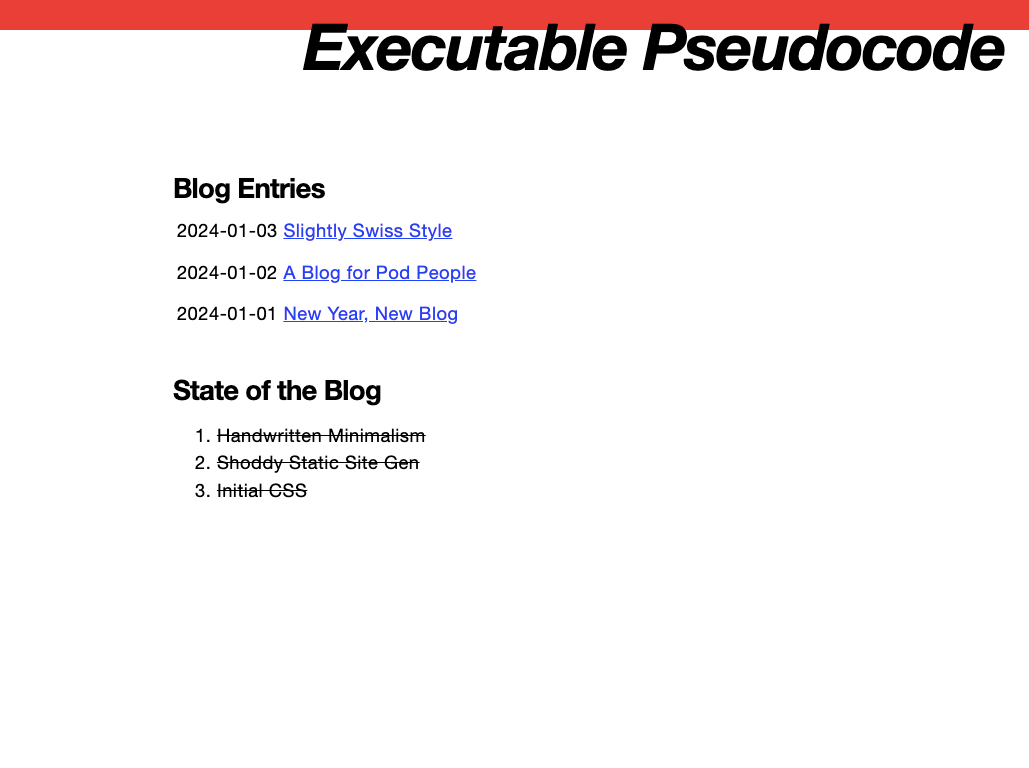Slightly Swiss Style
Yesterday I added a basic blog generator to my setup, but kept all style of the initial rollout. Which was based on an old bookmarklet I had that just centers the main content of a page and adds a decent line-height. This works surprisingly well for older web pages, and leaves enough of the original content so that I prefer it to a browser's reader mode quite often.
But alas, it's certainly not a recognizable style, unless I decide to go all-out old-school, use Times New Roman and maybe even a gray background.
In the end, I decided to go even further back and went for something that's so "tired", you barely see it now – and so the cycle begins again.
What you see before you are the three colors red, white and black, plus a variant of the Helvetica font if you haven't turned off this feature in your settings.
It's bland and plain, but it works.
Alternatives
Initially I was looking at some so-called class-less CSS frameworks. Those where you just include the file into a regular HTML file and it just works.
My first attempt was simple css, as I've seen this used for other minimalistic blogs.
It worked, but especially the front page looked a bit odd, and I wasn't too excited about parts of the typography. A quick attempt with Sakura didn't improve things a lot. Most class-less styles are just a bit over what you get with bettermotherfuckingwebsite.com, plus some fancier blockquotes.
Another common idea for a programming-focused web site is something with a monospaced font, evoking terminal nostalgia. Didn't want to go there, too. After all, this is about pseudocode not shell scripts.
I thought about borrowing a palette from Android Arts and going with a pastel 8-/16-bit style, but I'll probably keep that in mind for a more playful site.
Status Quo


Other News
I've got slight cold, so nothing too exciting happened to me today.
But right before writing this, I heard that Niklaus Wirth died a few days ago.
I hope that most people reading this blog have heard of him, but if not, please go to the linked Wikipedia page. He was one of the computing pioneers, but never one stuck in an ivory tower, always trying to get those new-fangled computers into the hands of users.
His Pascal programming language was widely used as a teaching tool, but also to program actual software. It's interesting, that it was much more used on the end-user targeted DOS and CP/M devices, instead of the mainframes of big corporations (COBOL was common there), or the slightly less high-powered, but still rather corporate Unix devices (where C took it's first slouching steps).
His follow-up languages also formed the cores of whole operating systems for devices built at the Swiss ETH university. It was next to impossible to get a setup where every user had their own machine and didn't just shared a bigger one, so Wirth and colleagues built it themselves.
The Lilith and Ceres workstations might look simple these days, but back when they were created they were a sight so see – rather powerful, but still making it possible for each student to comprehend the whole stack, from the electronics, the operating system to the language compiler and end-user programs.
He always strived for simplicity, even when pretty much the whole of the computer industry went in a different direction.
These days, when even "native" applications are basically three Chromes in a trench coat, it's hard to picture how a world that went along with his Plea for Lean Software would have looked like.